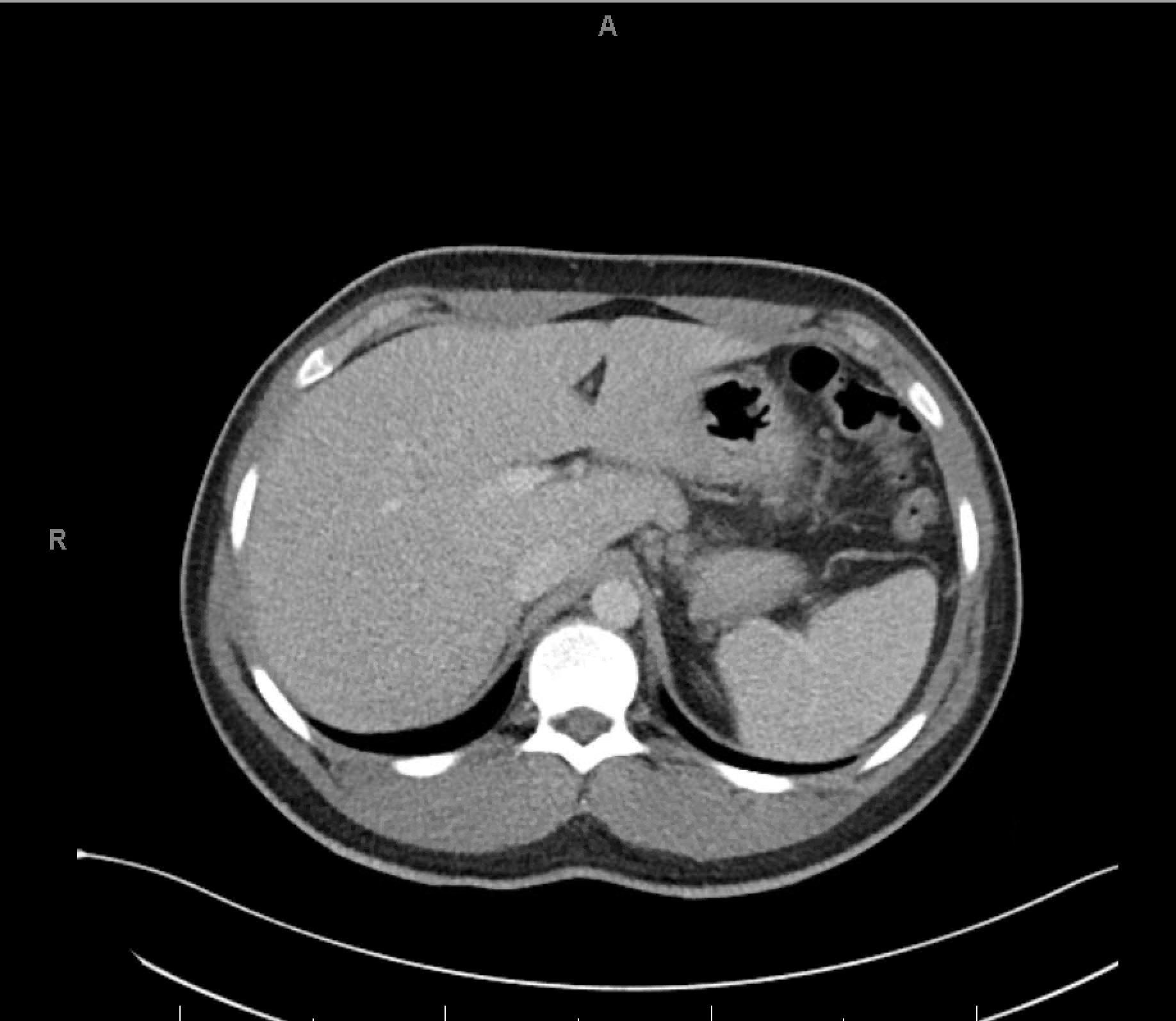Tuesday Poster Session
Category: Stomach and Spleen
P6390 - Unmasking the Cause: A Rare Case of Idiopathic Hypereosinophilic Syndrome in a Young Male Presenting with Symptoms of Gastroenteritis
Tuesday, October 28, 2025
10:30 AM - 4:00 PM PDT
Location: Exhibit Hall

Ivana Rubenstein, DO (she/her/hers)
Broward Health Medical Center
Fort Lauderdale, FL
Presenting Author(s)
Ivana Rubenstein, DO1, Keshavi Mahesh, MD2, Aryama Sharma, MD3
1Broward Health Medical Center, Fort Lauderdale, FL; 2Broward Health North, Pompano Beach, FL; 3Broward Health North, Deerfield Beach, FL
Introduction: Hypereosinophilic syndrome (HES) is a rare disorder characterized by persistent eosinophilia and organ damage. Idiopathic HES (IHES), a subtype without an identifiable secondary or clonal cause, can present with diverse symptoms. Gastrointestinal involvement occurs in 14% of cases. We present a case of IHES in a healthy young male presenting with diarrhea and vomiting.
Case Description/
Methods: An 18-year-old male recently immigrated from Brazil presented with watery, non-bloody diarrhea, abdominal pain, and non-bilious, non-bloody emesis. He denied recent animal exposure or travel in the U.S. On exam, he was tachycardic, hypertensive, and had right lower quadrant tenderness. CT imaging revealed pelvic free fluid, bilateral ground-glass opacities, and a small pericardial effusion. Laboratory studies demonstrated white blood cell count (WBC) of 51.97 × 10³/μL, elevated absolute eosinophil count (AEC) of 40.02 × 10³/μL, and transaminitis. Infectious workup, including stool cultures, Clostridium difficile testing, ova and parasites, and blood cultures, was negative.
The patient was started on antibiotics, metronidazole, and albendazole. Despite treatment, eosinophilia worsened. Systemic corticosteroids (prednisone 20 mg TID) were then initiated, resulting in rapid clinical and laboratory improvement: WBC decreased to 12.43 × 10³/μL and AEC to 2.61 × 10³/μL. Bone marrow biopsy revealed myeloid maturation with increased eosinophils and precursors, with no clonal or malignant features, consistent with IHES. Patients gastrointestinal symptoms resolved and the patient was discharged with follow up.
Discussion: HES can be classified as primary (neoplastic), secondary (reactive), or idiopathic. IHES is a diagnosis of exclusion and may mimic other diseases due to its variable presentation. In this case, GI symptoms and imaging findings of serosal effusions were prominent. Albendazole has been effective in treating parasitic causes of eosinophilia, but our patient failed to respond until corticosteroids were initiated. Bone marrow biopsy should be performed prior to steroid use if feasible. Prompt recognition and corticosteroid therapy are essential for favorable outcomes. Ruling out Strongyloides prior to steroids is critical, as immunosuppression can lead to fatal dissemination. Overall, this case highlights IHES as a rare but important differential diagnosis in patients presenting with GI symptoms and marked eosinophilia.

Figure: Figure 1: CT abdomen and pelvis showing nonspecific fluid in pelvis.
Disclosures:
Ivana Rubenstein indicated no relevant financial relationships.
Keshavi Mahesh indicated no relevant financial relationships.
Aryama Sharma indicated no relevant financial relationships.
Ivana Rubenstein, DO1, Keshavi Mahesh, MD2, Aryama Sharma, MD3. P6390 - Unmasking the Cause: A Rare Case of Idiopathic Hypereosinophilic Syndrome in a Young Male Presenting with Symptoms of Gastroenteritis, ACG 2025 Annual Scientific Meeting Abstracts. Phoenix, AZ: American College of Gastroenterology.
1Broward Health Medical Center, Fort Lauderdale, FL; 2Broward Health North, Pompano Beach, FL; 3Broward Health North, Deerfield Beach, FL
Introduction: Hypereosinophilic syndrome (HES) is a rare disorder characterized by persistent eosinophilia and organ damage. Idiopathic HES (IHES), a subtype without an identifiable secondary or clonal cause, can present with diverse symptoms. Gastrointestinal involvement occurs in 14% of cases. We present a case of IHES in a healthy young male presenting with diarrhea and vomiting.
Case Description/
Methods: An 18-year-old male recently immigrated from Brazil presented with watery, non-bloody diarrhea, abdominal pain, and non-bilious, non-bloody emesis. He denied recent animal exposure or travel in the U.S. On exam, he was tachycardic, hypertensive, and had right lower quadrant tenderness. CT imaging revealed pelvic free fluid, bilateral ground-glass opacities, and a small pericardial effusion. Laboratory studies demonstrated white blood cell count (WBC) of 51.97 × 10³/μL, elevated absolute eosinophil count (AEC) of 40.02 × 10³/μL, and transaminitis. Infectious workup, including stool cultures, Clostridium difficile testing, ova and parasites, and blood cultures, was negative.
The patient was started on antibiotics, metronidazole, and albendazole. Despite treatment, eosinophilia worsened. Systemic corticosteroids (prednisone 20 mg TID) were then initiated, resulting in rapid clinical and laboratory improvement: WBC decreased to 12.43 × 10³/μL and AEC to 2.61 × 10³/μL. Bone marrow biopsy revealed myeloid maturation with increased eosinophils and precursors, with no clonal or malignant features, consistent with IHES. Patients gastrointestinal symptoms resolved and the patient was discharged with follow up.
Discussion: HES can be classified as primary (neoplastic), secondary (reactive), or idiopathic. IHES is a diagnosis of exclusion and may mimic other diseases due to its variable presentation. In this case, GI symptoms and imaging findings of serosal effusions were prominent. Albendazole has been effective in treating parasitic causes of eosinophilia, but our patient failed to respond until corticosteroids were initiated. Bone marrow biopsy should be performed prior to steroid use if feasible. Prompt recognition and corticosteroid therapy are essential for favorable outcomes. Ruling out Strongyloides prior to steroids is critical, as immunosuppression can lead to fatal dissemination. Overall, this case highlights IHES as a rare but important differential diagnosis in patients presenting with GI symptoms and marked eosinophilia.

Figure: Figure 1: CT abdomen and pelvis showing nonspecific fluid in pelvis.
Disclosures:
Ivana Rubenstein indicated no relevant financial relationships.
Keshavi Mahesh indicated no relevant financial relationships.
Aryama Sharma indicated no relevant financial relationships.
Ivana Rubenstein, DO1, Keshavi Mahesh, MD2, Aryama Sharma, MD3. P6390 - Unmasking the Cause: A Rare Case of Idiopathic Hypereosinophilic Syndrome in a Young Male Presenting with Symptoms of Gastroenteritis, ACG 2025 Annual Scientific Meeting Abstracts. Phoenix, AZ: American College of Gastroenterology.
